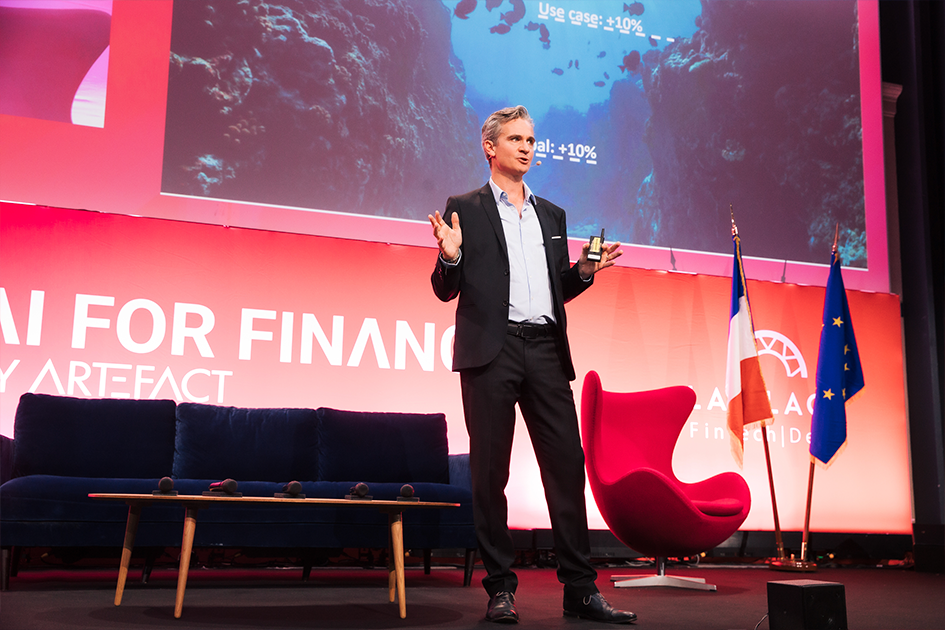AI for Finance Summit by Artefact - September 17th, 2024 - Paris
Key learnings from the keynote by Adrien Vesteghem, AI Program Director at BNP Paribas.
Introduction and focus on AI for business
Adrien Vesteghem opened his keynote by clarifying that unlike more mainstream AI applications like self-driving cars or content creation, his work centers on leveraging AI to add value to business operations. He stressed the importance of determining the expected value of AI initiatives based on an organization’s maturity level and how even doing nothing could still result in some passive AI-driven benefits. However, actively adopting AI can provide significant value, starting with a “simple generative” approach, which could deliver operational efficiency and boost margins by around 5%.
Data Science and MLOps
As BNP Paribas advanced in its AI journey, the next stage involved adopting data science and machine learning operations (MLOps) skills. Vesteghem likened this stage to becoming “gold diggers,” seeking high-value AI use cases that could drive up margins by an additional 10%. He shared that BNP Paribas has been at this level for several years and explained that this phase is about deploying AI solutions across the business and uncovering valuable “golden nuggets.” Vesteghem emphasized that identifying and deploying these use cases has been instrumental in advancing BNP Paribas’ AI capabilities.
The global AI approach: Integration and scaling
The third level of AI maturity, as Vesteghem describes, is a “Global AI approach,” integrating AI across all business areas to boost value and potentially increase margins by up to 25%. However, Vesteghem stresses the importance of moving from a use-case-driven approach to a product-focused mindset. He gives an example of unifying various business needs under one AI product for personalized customer content, streamlining resources and reducing costs.
Smart Inbox Example: From Use Case to AI Product
To explain the product-based approach further, Vesteghem shared the story of a project called “Smart Inbox,” initially intended as a simple email triaging solution. Though the project initially seemed to have a negative ROI, the team realized its potential as an AI product over time. The Smart Inbox evolved into a more comprehensive solution, incorporating features like automated email responses and document management. This transformation demonstrated the value of looking beyond individual use cases and investing in scalable AI products that serve broader business needs.
Look far for long-term value
Vesteghem’s first key lesson was to “look far” and not abandon AI projects prematurely. He underscored that long-term vision allows for the evolution of simple solutions into complex products, as was the case with the Smart Inbox. His second piece of advice was to “look deep” and continuously challenge existing solutions. He shared a lesson learned from a document processing AI project, where initial results of 50% accuracy were significantly improved by re-evaluating the technology and opting for more effective open-source solutions, raising the accuracy to 90–99%.
Measure AI effectiveness and mitigate risks
His third and final lesson emphasized the importance of “measuring” the effectiveness of AI initiatives, particularly when deploying generative AI. Vesteghem shared how the fear of generative AI’s limitations, such as hallucinations, led them to partner with external entities like J. Gard to assess and measure risks. This helped BNP Paribas better mitigate risks in customer-facing AI applications, such as generative chatbots, crucial for the banking sector’s risk-sensitive environment.
Conclusion
Adrien Vesteghem wrapped up his keynote by reflecting on the possibility of future AI maturity levels that BNP Paribas may reach. While the future is uncertain, he expressed confidence that continued learning and adaptation will lead to new insights, closing his talk with a message of optimism and an invitation for further discussion.

 BLOG
BLOG



